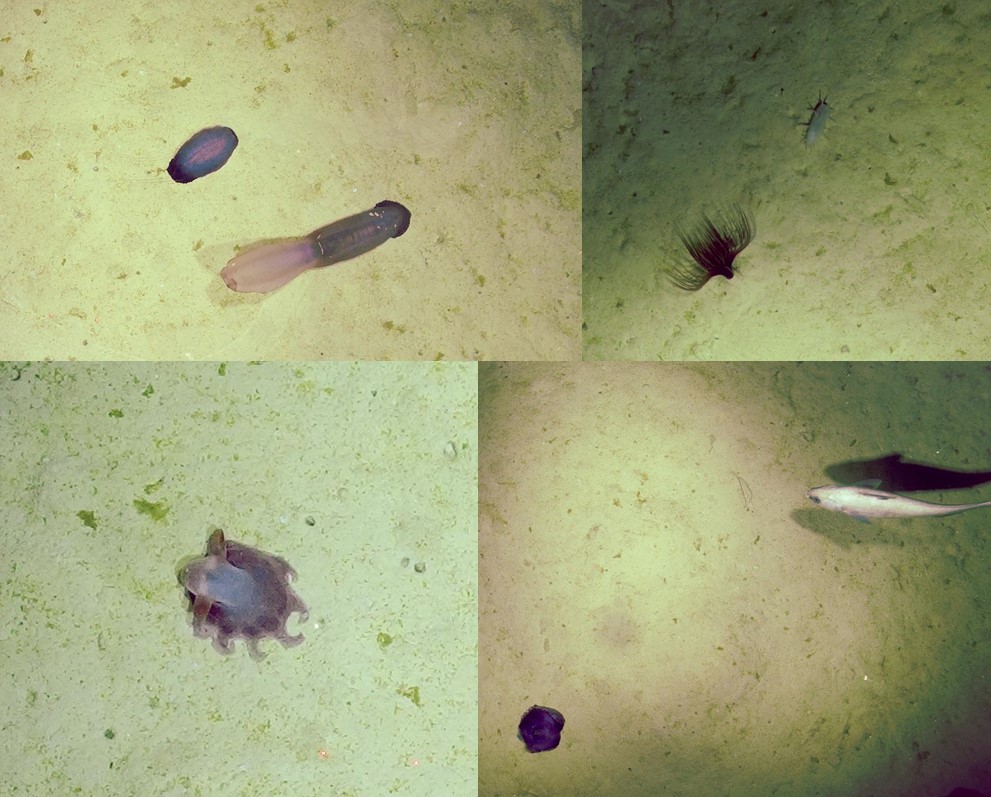Updates from the field
Lisa Skein, Anita Flohr & Andrew Gates
The JC263 expedition is progressing well, and so today we’ve chosen to reflect on the activities performed thus far aboard the RRS James Cook. Over the past couple of weeks, many terabytes of extremely valuable multidisciplinary data have been collected spanning deep-sea biology, oceanography, sedimentology, and geology.
Whittard Canyon: sedimentology & oceanography
Following a fairly smooth transit from Southampton, we arrived at Whittard Canyon. Here, in the Eastern Branch of the canyon, a sediment trap mooring has been maintained since 2019. This sampling device is designed to provide insight into the frequency and magnitude of sediment flows that pass through the canyon. These data help scientists to better understand the physical processes that shape submarine canyon ecosystems, and to assess risks to submarine cables that can be severely damaged by these underwater ‘avalanches’. Additional data to further unpack these processes were collected via five full water depth CTD casts that aimed to document variations in turbidity across the canyon system, in addition to other physical oceanographic parameters that are also being used to track plankton blooms.
PAP: Benthic activities
Once operations were completed at Whittard Canyon, we set off to the Porcupine Abyssal Plain Sustained Observatory (PAP-SO); a ride that was fairly bumpy and a good initiation for those whose sea-legs had not yet been activated! Continued rough seas prevented the benthic team from coring the first night at PAP, but as soon as the weather subsided seabed operations kicked off in full swing. At the PAP-Central coring site, we have thus far completed 11 megacore deployments, whose contents will be analysed for macrofaunal analysis, trophic isolate analysis, DNA analysis, and a microbial experiment currently running on board.
We have also deployed one Bathysnap time-lapse camera that is currently completing a high frequency time-lapse photography study and will be retrieved in the coming days. We then plan a second Bathysnap deployment, however this one will be left to take photographs of the seabed for a whole year before its retrieval. While we need to wait a while for the first look at Bathysnap’s photos, the HyBIS visual surveys are delivering a real-time feed to the ship which has kept the team occupied over the most recent nights. Our first three nights of HyBIS surveys at the PAP-Central site have already delivered some classic abyssal faunal sightings, with the likes of the big purple sea cucumber Psychropotes sp., rattail fish (Coryphaenoides sp), cerianthid anemones, stalked sponges, soft corals, and a very cute dumbo octopus!

We have also deployed two baited trap experiments that were recovered after 48 hours and delivered good catches! These experiments have been carried out since 1985 and by repeating them we are able to understand long-term change in the animals that live near the seabed [1]. The specimens collected form part of the Discovery Collections [2] at the National Oceanography Centre for further investigation, and may perhaps even lead to the discovery of new species!
PAP: Pelagic activities
The pelagic team have been busy working on a series of moorings that provide year-round data at the PAP-SO. The largest mooring is the PAP-1 Met Office surface ocean buoy and sub-surface sensor package. The buoy is tethered to an anchor at the seabed nearly 5000 m below, so deployment is a huge team effort between the ship’s crew, technicians and scientists. The buoy forms part of the UK Met Office’s network and informs the weather forecast (see [3] for The Met Office data). The oceanographic data are part of several other networks including the Integrated Carbon Observing System (ICOS) [4] and OceanSITES [5] to ensure that the observations inform wider ocean observation efforts. Another mooring turned around by the pelagic team is a long-term sediment trap that catches sinking particles in the water column, telling us about the downward flux of material from the top of the ocean into the interior. A recent paper analysed >30 years of this dataset and found links to the dynamics of the plankton communities in the upper ocean, helping to understand the sequestration of carbon through the biological carbon pump [6].

The moorings operations are supported by a series of deployments of the CTD, a device lowered through the water column to measure a range of parameters with different sensors and collect water samples at different depths. The data generated are used as part of the long-term PAP-SO time series, and to calibrate the sensors we deploy and recover on our moorings. Throughout the cruise we are also monitoring primary productivity in the region through an early morning CTD sampling cast each day.
We are making good progress on our objectives but still have several important tasks to complete…More from JC263 soon!
Links:
[1] https://www.sciencedirect.com/science/article/pii/S0079661120300574
[2] https://noc.ac.uk/facilities/discovery-collections
[6] https://www.frontiersin.org/articles/10.3389/feart.2023.1176196/full